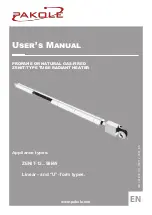
16
17
• Encienda el equipo y pulse la tecla de modo tiempo ‘
π
‘. Pulse la tecla ‘
▲
’ o ‘
▼
’
para establecer el tiempo deseado (pulsando la tecla de modo tiempo ‘
π
‘, usted
puede elegir entre pasos de un minuto o un segundo).
• Pulse la tecla ‘START’. Comienza el calentamiento y se oirá un sonido “buzz”
suave.
• Si se pulsa la tecla de temperatura ‘
·
‘ durante el calentamiento, la temperatura
actual se mostrará durante 3 segundos. Después, se reanuda la cuenta atrás.
• Durante el proceso de calentamiento, el tiempo configurado llega a 00:00. Cuando
se alcanza 00:00, el calentador de inducción se apaga. La pieza de trabajo es
entonces automáticamente desmagnetizada y se emite un fuerte “bip” continuo.
Pulse la tecla ‘STOP’ para apagar el equipo.
Retirada de la pieza de trabajo
• Después de pulsar la tecla ‘STOP’, coloque la sonda en el lateral del poste vertical.
Pulsar la tecla ‘STOP’ produce siempre la acción de desmagnetización de la pieza
de trabajo.
• Utilizando guantes resistentes al calor, sujete el yugo con el rodamiento en él y
colóquelo sobre una superficie limpia y resistente al calor. Monte el rodamiento
inmediatamente para evitar su enfriamiento. Si utiliza un modelo con un brazo
oscilante, haga oscilar el yugo con el rodamiento en la posición fija abierta (a
45o). Deslice el rodamiento del yugo. Monte el rodamiento inmediatamente para
evitar la pérdida de calor.
Avería
• Si la temperatura de la pieza de trabajo no aumenta en 1
o
(C o F) en un plazo de
tiempo predeterminado, el calentador se apaga automáticamente. Aparecerán
cuatro rayas destellantes (----) en la pantalla, y se emitirá un fuerte “bip”
intermitente. Pulse la tecla ‘STOP’ para detener el “bip” y para comprobar si:
• la sonda sigue sujeta a la pieza de trabajo, y está conectada correctamente en
su enchufe.
• el cable de la sonda ha sido dañado.
• la superficie de la sonda está limpia.
• la capacidad del calentador es demasiado pequeña para la pieza de trabajo.
Si la sonda está defectuosa, se puede seguir utilizando el Modo Tiempo. La
temperatura debe comprobarse utilizando un termómetro externo.
noticeheaterE.indd 16
17/10/06 14:04:50
Summary of Contents for VHIN 10
Page 204: ...noticeheaterRU indd 2 17 10 06 14 30 28...
Page 206: ...4 1 5 150o C 302o F noticeheaterRU indd 4 17 10 06 14 30 28...
Page 207: ...5 RU in out 1 noticeheaterRU indd 5 17 10 06 14 30 29...
Page 211: ...9 RU 3 3 230V 110V 1 2 400 450 500V 1 2 noticeheaterRU indd 9 17 10 06 14 30 30...
Page 212: ...10 4 noticeheaterRU indd 10 17 10 06 14 30 31...
Page 213: ...11 RU 5 5 2 1 in out noticeheaterRU indd 11 17 10 06 14 30 32...
Page 214: ...12 5 1 2 150 C noticeheaterRU indd 12 17 10 06 14 30 34...
Page 216: ...14 6 240 464 F VHIN10 noticeheaterRU indd 14 17 10 06 14 30 38...
Page 219: ...17 RU 8 noticeheaterRU indd 17 17 10 06 14 30 38...
Page 224: ...noticeheaterPRC indd 2 17 10 06 14 32 31...
Page 226: ...4 1 5m 16ft 150o C 302o F noticeheaterPRC indd 4 17 10 06 14 32 32...
Page 227: ...5 PRC in out 1 3 3ft noticeheaterPRC indd 5 17 10 06 14 32 32...
Page 231: ...9 PRC 3 3 230V 110V 1 2 400 450 500V 1 2 noticeheaterPRC indd 9 17 10 06 14 32 34...
Page 232: ...10 4 noticeheaterPRC indd 10 17 10 06 14 32 34...
Page 233: ...11 PRC 5 5 2 1 in out noticeheaterPRC indd 11 17 10 06 14 32 35...
Page 234: ...12 5 1 2 150 C 302 F noticeheaterPRC indd 12 17 10 06 14 32 37...
Page 236: ...14 6 2 4 0 o C 4 6 4 o F VHIN10 noticeheaterPRC indd 14 17 10 06 14 32 41...
Page 239: ...17 PRC 8 noticeheaterPRC indd 17 17 10 06 14 32 41...
Page 244: ...Notes noticeheaterGB indd 22 17 10 06 15 56 16...
Page 245: ...Notes noticeheaterGB indd 22 17 10 06 15 56 16...
Page 246: ...Notes noticeheaterGB indd 22 17 10 06 15 56 16...
Page 248: ...A1 noticeheaterGB indd 24 17 10 06 15 56 20...
Page 249: ...A2 noticeheaterGB indd 25 17 10 06 15 56 38...
















































